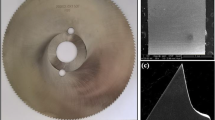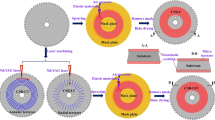Abstract
In order to explore the influence of textured sawteeth on saw blade cutting and wear performance, linear micro textures perpendicular to the chip flow direction were fabricated on the rake face, main flank face, and secondary flank face by laser machining, respectively. The cutting tests were carried out on sawing platform with different cutting speeds under lubrication conditions. The cutting forces, noise, temperatures, machined surface quality, and sawtooth wear were investigated. The results indicated that textures fabricated on the secondary flank face can effectively reduce friction with the machined surface and improve the surface quality, and the roughness Ra decreased about 2.5 ~ 12.5% compared with traditional saw blade. The improvement of saw blade cutting performance by machining micro textures on the main flank face was greater than the textures fabricated on the rake face. Due to the synergistic action of textures on different cutting faces, the cutting force, noise, and temperature of saw blades with textures prepared on all cutting surfaces were the lowest. The main wear forms of sawteeth were tip wear, surface adhesion wear, and oxidation wear. Although the derivative cutting phenomenon occurred, the micro textures were not completely filled, which signified that the micro textures still played the role of stored cutting fluids, reduced contact area, and formed lubrication film.


















Similar content being viewed by others
Abbreviations
- F x :
-
Axial force (N)
- F y :
-
Horizontal force (N)
- F z :
-
Vertical force (N)
- F f :
-
Friction force between the chip and sawteeth (N)
- v :
-
Sawing speed (m/min)
- f :
-
Feed rate (mm/r)
- L :
-
Sawing arc length (mm)
- λ :
-
Sawing depth (mm)
- R 1 :
-
Diameter of the circular saw blades (mm)
- R :
-
External diameter of the workpiece (mm)
- r :
-
Inside diameter of the workpiece (mm)
- X :
-
Common chord length between the circular saw blade and the workpiece external diameter (mm)
- x :
-
Common chord length between the circular saw blade and the workpiece external diameter (mm)
- h :
-
Wall thickness of the pipes (mm)
- τ s :
-
Shear strength of 304 stainless steel pipes (MPa)
- τ m :
-
Shear strength of lubricating film (MPa)
- A :
-
Friction area (mm2)
- A s :
-
Contact area between sawteeth and chip (mm2)
- A m :
-
Area of lubricating film (mm2)
- l f :
-
Friction length between chip and sawteeth (mm)
References
Nishio S, Marui E (1996) Effects of slots on the lateral vibration of a circular saw blade. Int J Mach Tools Manuf 36:771–787. https://doi.org/10.1016/0890-6955(95)00088-7
Abrão A, Moreira M, Faria P, Campos Rubio J (2014) High-performance circular sawing of AISI 1045 steel with cermet and tungsten carbide inserts. J Mech Sci Technol 28:4275–4282. https://doi.org/10.1007/s12206-014-0941-5
Aydin G, Karakurt I, Aydiner K (2013) Development of predictive models for the specific energy of circular diamond sawblades in the sawing of granitic rocks. Rock Mech Rock Eng 46:767–783. https://doi.org/10.1007/s00603-012-0290-6
Celep O, Aydin G, Karakurt I (2013) Diamond recovery from waste sawblades: a preliminary investigation. Proc Inst Mech Eng Part B J Eng Manuf 227:917–921. https://doi.org/10.1177/0954405412471524
Liu N, Xu Y, Li H, Chen M, Zhou J, **e F, Yang H (2005) Cutting and wearing characteristics of TiC-based cermets cutters with nano-TiN addition. J Mater Process Technol 161:478–484. https://doi.org/10.1016/j.jmatprotec.2004.07.087
Aydin G, Karakurt I, Hamzacebi C (2015) Performance prediction of diamond sawblades using artificial neural network and regression analysis. Arab J Sci Eng 40:2003–2012. https://doi.org/10.1007/s13369-015-1589-x
Fang C, Huang H, Xu X (2011) The effects of the geometric parameters of segmented sawblades on the fluctuated temperatures in sawing. Solid State Phenom 175:93–96. https://doi.org/10.4028/www.scientific.net/SSP.175.93
Sarwar M, Bradbury S, Lewis D (1996) Optimizing the performance of high speed steel circular saw blades machining cupro 107, Inconel 600L and Nimonic PK31 nickel based alloys. J Mater Sci 31:3613–3616. https://doi.org/10.1007/BF00352768
Aydin G, Karakurt I, Aydiner K (2013) Investigation of the surface roughness of rocks sawn by diamond sawblades. Int J Rock Mech Min Sci 61:171–182. https://doi.org/10.1016/j.ijrmms.2013.03.002
Svoreň J, Naščák Ľ, Koleda P, Barcík Š, Němec M (2021) The circular saw blade body modification by elastic material layer effecting circular saws sound pressure level when idling and cutting. Appl Acoust 179:108028. https://doi.org/10.1016/j.apacoust.2021.108028
Aydin G, Karakurt I, Aydiner K (2013) Wear performance of saw blades in processing of granitic rocks and development of models for wear estimation. Rock Mech Rock Eng 46:1559–1575. https://doi.org/10.1007/s00603-013-0382-y
Bradbury S, Lewis D, Sarwar M (1996) The effect of product quality on the integrity of advanced surface engineering treatments applied to high speed steel circular saw blades. Surf Coatings Technol 85:215–220. https://doi.org/10.1016/0257-8972(95)02756-4
Wan Q, Gao P, Zhang Z (2021) Friction and wear performance of lubricated micro-textured surface formed by laser processing. Surf Eng 37:1523–1531. https://doi.org/10.1080/02670844.2021.1952041
Chen L, Liu Z, Song W (2020) Process-surface morphology-tribological property relationships for H62 brass employing various manufacturing approaches. Tribol Int 148:106320. https://doi.org/10.1016/j.triboint.2020.106320
Cui X, Yan K, Guo J, Wang D (2019) Biomimetic micro-textures, mechanical behaviors and intermittent turning performance of textured Al2O3/TiC micro-composite and micro-nano-composite ceramics. Ceram Int 45:19934–19947. https://doi.org/10.1016/j.ceramint.2019.06.251
Zou M, Cai L, Wang H, Yang D, Wyrobek T (2005) Adhesion and friction studies of a selectively micro/nano-textured surface produced by UV assisted crystallization of amorphous silicon. Tribol Lett 20:43–52. https://doi.org/10.1007/s11249-005-7791-3
Kishawy H, Salem A, Hegab H, Hosseinia A, Balazinski M (2021) Micro-textured cutting tools: phenomenological analysis and design recommendations. CIRP Ann 70:65–68. https://doi.org/10.1016/j.cirp.2021.04.081
Liu X, Liu Y, Li L, Tian Y (2019) Performances of micro-textured WC-10Ni3Al cemented carbides cutting tool in turning of Ti6Al4V. Int J Refract Met Hard Mater 84:104987. https://doi.org/10.1016/j.ijrmhm.2019.104987
Tong X, Yu S (2020) Influence of micro-textured parameters on cutting performance and chip formation of milling Ti6Al4V. J Mech Sci Technol 34:3767–3774. https://doi.org/10.1007/s12206-020-0828-9
Pang K, Wang D (2020) Study on the performances of the drilling process of nickel-based superalloy Inconel 718 with differently micro-textured drilling tools. Int J Mech Sci 180:105658. https://doi.org/10.1016/j.ijmecsci.2020.105658
Niketh S, Samuel GL (2017) Surface texturing for tribology enhancement and its application on drill tool for the sustainable machining of titanium alloy. J Clean Prod 167:253–270. https://doi.org/10.1016/j.jclepro.2017.08.178
Karakurt I, Aydin G, Aydiner K (2013) Predictive modelling of noise level generated during sawing of rocks by circular diamond sawblades. Sadhana - Acad Proc Eng Sci 38:491–511. https://doi.org/10.1007/s12046-013-0117-5
Karakurt I, Aydin G, Aydiner K (2013) Experimental and statistical analysis of cutting force acting on diamond sawblade in sawing of granitic rocks. Proc Inst Mech Eng Part B J Eng Manuf 227(2):286–300. https://doi.org/10.1177/0954405412460971
Lu Y, Deng J, Sun Q, Ge D, Wu J, Zhang Z (2021) Effect of micro textures on the cutting performance of circular saw blade. Int J Adv Manuf Technol 115:2889–2903. https://doi.org/10.1007/s00170-021-07348-0
Orra K, Choudhury SK (2018) Tribological aspects of various geometrically shaped micro-textures on cutting insert to improve tool life in hard turning process. J Manuf Process 31:502–513. https://doi.org/10.1016/j.jmapro.2017.12.005
Duan R, Deng J, Lei S, Ge D, Liu Y, Li X (2019) Effect of derivative cutting on machining performance of micro textured tools. J Manuf Process 45:544–556. https://doi.org/10.1016/j.jmapro.2019.07.037
Sugihara T, Kobayashi R, Enomoto T (2021) Direct observations of tribological behavior in cutting with textured cutting tools. Int J Mach Tools Manuf 168:103726. https://doi.org/10.1016/j.ijmachtools.2021.103726
Kawasegi N, Sugimori H, Morimoto H, Morita N, Hori I (2009) Development of cutting tools with microscale and nanoscale textures to improve frictional behavior. Precis Eng 33:248–254. https://doi.org/10.1016/j.precisioneng.2008.07.005
Chen L, Liu Z, Wang B, Song Q, Wan Y, Chen L (2019) Surface characterization and tribological performance of anodizing micro-textured aluminum-silicon alloys. Materials 12:1862. https://doi.org/10.3390/ma12111862
He D, He C, Li W, Shang L, Wang L, Zhang G (2020) Tribological behaviors of in-situ textured DLC films under dry and lubricated conditions. Appl Surf Sci 525:146581. https://doi.org/10.1016/j.apsusc.2020.146581
Tewelde F, Zhou T, Zhou J, Guo W, Zhao B, Ge X, Wang W, Wang X, Wang X (2023) Asymmetric surface texturing for directional friction control under dry sliding condition. Tribol Int 181:108321. https://doi.org/10.1016/j.triboint.2023.108321
Wang Z, Zhao Q, Wang C, Zhang Y (2015) Modulation of dry tribological property of stainless steel by femtosecond laser surface texturing. Appl Phys A 119:1155–1163. https://doi.org/10.1007/s00339-015-9085-4
Zhan X, Yi P, Liu Y, **ao P, Zhu X, Ma J (2019) Effects of single- and multi-shape laser-textured surfaces on tribological properties under dry friction. Proc Inst Mech Eng Part C J Mech Eng Sci 234:1382–1392. https://doi.org/10.1177/0954406219892294
Ding X, Chen D, Zhang W, Yu S (2020) Experiment of frictional vibration performance of the micro-texture of DLC thin film with dry gas seal rings. Tribol Int 147:106267. https://doi.org/10.1016/j.triboint.2020.106267
Wang L, Guo S, Wei Y, Yuan G, Geng H (2019) Optimization research on the lubrication characteristics for friction pairs surface of journal bearings with micro texture. Meccanica 54:1135–1148. https://doi.org/10.1007/s11012-019-01015-1
Scaraggi M, Mezzapesa FP, Carbone G, Ancona A, Sorgente D, Lugarà P (2014) Minimize friction of lubricated laser-microtextured-surfaces by tuning microholes depth. Tribol Int 75:123–127. https://doi.org/10.1016/j.triboint.2014.03.014
Suh M, Chae Y, Kim S, Hinoki T, Kohyama A (2010) Effect of geometrical parameters in micro-grooved crosshatch pattern under lubricated sliding friction. Tribol Int 43:1508–1517. https://doi.org/10.1016/j.triboint.2010.02.012
Zhang W, Cao T (2023) Cutting performance of a tool with continuous lubrication of atomized cutting fluid at the tool-chip interface. Int J Adv Manuf Technol 126:117–130. https://doi.org/10.1007/s00170-023-11116-7
Cao T, Li Z, Zhang S, Zhang W (2023) Cutting performance and lubrication mechanism of microtexture tool with continuous lubrication on tool-chip interface. Int J Adv Manuf Technol 125:1815–1826. https://doi.org/10.1007/s00170-023-10821-7
Sedlaček M, Podgornik B, Ramalho A, Česnik D (2017) Influence of geometry and the sequence of surface texturing process on tribological properties. Tribol Int 115:268–273. https://doi.org/10.1016/j.triboint.2017.06.001
Geng J, Chen S, **n S, Guo Y, Yang S (2021) Surface/interface texture enhanced tribological properties of graphene sheets embedded carbon films. Tribol Int 163:107191. https://doi.org/10.1016/j.triboint.2021.107191
Chen RY (1985) Principle of metal cutting, 1st edn. China Machine Press, Bei**g
Tie L, Guo Z, Liu W (2015) Anisotropic wetting properties on various shape of parallel grooved microstructure. J Colloid Interface Sci 453:142–150. https://doi.org/10.1016/j.jcis.2015.04.066
Itoigawa F, Childs T, Nakamura T, Belluco W (2006) Effects and mechanisms in minimal quantity lubrication machining of an aluminum alloy. Wear 260:339–344. https://doi.org/10.1016/j.wear.2005.03.035
Li B, Rui Z (2019) Friction and wear behaviours of YG8 sliding against austempered ductile iron under dry, chilled air and minimal quantity lubrication conditions. Adv Mech Eng 11:1687814019847064. https://doi.org/10.1177/1687814019847064
Liu N, Han C, Xu Y, Chao S, Shi M, Feng J (2004) Microstructures and mechanical properties of nanoTiN modified TiC-based cermets for the milling tools. Mater Sci Eng A 382:122–131. https://doi.org/10.1016/j.msea.2004.04.053
Funding
This work is supported by the National Natural Science Foundation of China (52275443) and the Key Research and Development Projects of Shandong Province (2020CXGC011003).
Author information
Authors and Affiliations
Contributions
Yang Lu: formal analysis, methodology, data curation, and writing original draft. Jianxin Deng: conceptualization and supervision. Zhihui Zhang: supervision. Yichen Bao: writing, review, and editing. Runzhou Tian: investigation.
Corresponding author
Ethics declarations
Competing interests
The authors declare no competing interests.
Additional information
Publisher's Note
Springer Nature remains neutral with regard to jurisdictional claims in published maps and institutional affiliations.
Rights and permissions
Springer Nature or its licensor (e.g. a society or other partner) holds exclusive rights to this article under a publishing agreement with the author(s) or other rightsholder(s); author self-archiving of the accepted manuscript version of this article is solely governed by the terms of such publishing agreement and applicable law.
About this article
Cite this article
Lu, Y., Deng, J., Zhang, Z. et al. The cutting performance of saw blades with textured structures on the rake face, main flank face, and secondary flank face. Int J Adv Manuf Technol 131, 4915–4933 (2024). https://doi.org/10.1007/s00170-024-13345-w
Received:
Accepted:
Published:
Issue Date:
DOI: https://doi.org/10.1007/s00170-024-13345-w




